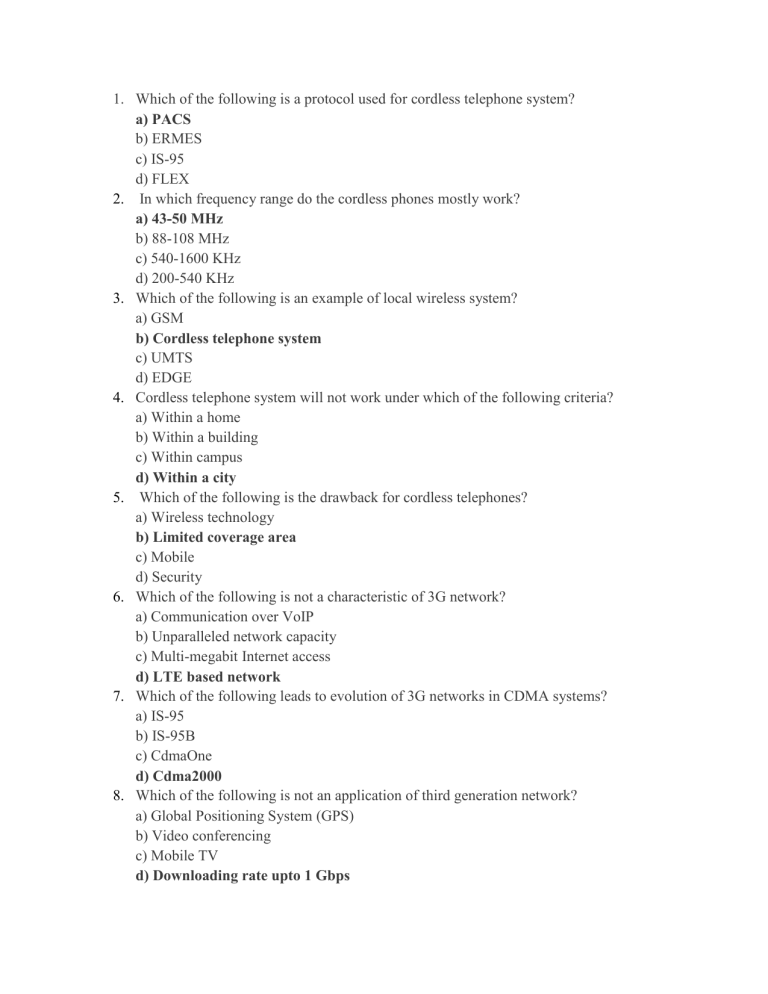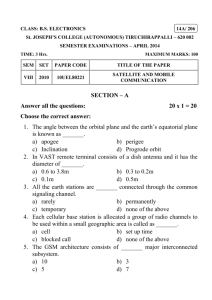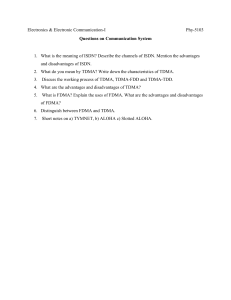Wireless Communication MCQs: Cordless, 3G, Cellular Systems
advertisement

1. Which of the following is a protocol used for cordless telephone system? a) PACS b) ERMES c) IS-95 d) FLEX 2. In which frequency range do the cordless phones mostly work? a) 43-50 MHz b) 88-108 MHz c) 540-1600 KHz d) 200-540 KHz 3. Which of the following is an example of local wireless system? a) GSM b) Cordless telephone system c) UMTS d) EDGE 4. Cordless telephone system will not work under which of the following criteria? a) Within a home b) Within a building c) Within campus d) Within a city 5. Which of the following is the drawback for cordless telephones? a) Wireless technology b) Limited coverage area c) Mobile d) Security 6. Which of the following is not a characteristic of 3G network? a) Communication over VoIP b) Unparalleled network capacity c) Multi-megabit Internet access d) LTE based network 7. Which of the following leads to evolution of 3G networks in CDMA systems? a) IS-95 b) IS-95B c) CdmaOne d) Cdma2000 8. Which of the following is not an application of third generation network? a) Global Positioning System (GPS) b) Video conferencing c) Mobile TV d) Downloading rate upto 1 Gbps 9. What is a cell in cellular system? a) A group of cells b) A group of subscribers c) A small geographical area d) A large group of mobile systems 10. What is frequency reuse? a) Process of selecting and allocating channels b) Process of selection of mobile users c) Process of selecting frequency of mobile equipment d) Process of selection of number of cells 11. Which of the following is a universally adopted shape of cell? a) Square b) Circle c) Triangle d) Hexagon 12. Actual radio coverage of a cell is called __________ a) Fingerprint b) Footprint c) Imprint d) Matrix 13. Why the shape of cell is not circle? a) Omni directionality b) Small area c) Overlapping regions or gaps are left d) Complex design 14. For a cellular system, if there are N cells and each cell is allocated k channel. What is the total number of available radio channels, S? a) S=k*N b) S=k/N c) S=N/k d) S=kN 15. What is a frequency reuse factor for N number of cells in a system? a) N b) N2 c) 2*N d) 1/N 16. A spectrum of 30 MHz is allocated to a cellular system which uses two 25 KHz simplex channels to provide full duplex voice channels. What is the number of channels available per cell for 4 cell reuse factor? a) 150 channels b) 600 channels c) 50 channels d) 85 channels 17. What is MIN? a) Subscriber’s telephone number b) Paging message c) Traffic request number d) Mobile Internet 18. What is handoff? a) Forward channel b) Switching technique c) Roamer d) Guard channel 19. Which one is not an advantage of using frequency reuse? a) Increased capacity b) Limited spectrum is required c) Same spectrum may be allocated to other network d) Number of base stations is reduced 20. The interference between the neighbouring base stations is avoided by ____________ a) Assigning different group of channels b) Using transmitters with different power level c) Using different antennas d) Using different base stations 21. What is the function of FVC (Forward Voice Channel)? a) Voice transmission from base station to mobiles b) Voice transmission from mobile to base station c) Initiating mobile calls d) Broadcast all traffic request for all mobile 22. Who has the responsibility of billing and system maintenance function in cellular system? a) Base Station b) PSTN c) MSC d) Mobile system 23. What is the responsibility of MSC in cellular telephone system? a) Connection of mobile to base stations b) Connection of mobile to PSTN c) Connection of base station to PSTN d) Connection of base station to MSC 24. Frequency division multiple access (FDMA) assigns ______ channels to _______ users. a) Individual, individual b) Many, individual c) Individual, many d) Many, many 25. The FDMA channel carries ____________ phone circuit at a time. a) Ten b) Two c) One d) Several 26. The bandwidth of FDMA channel is ______ a) Wide b) Narrow c) Large d) Zero 27. __________ is based on FDMA/FDD. a) GSM b) W-CDMA c) Cordless telephone d) AMPS 28. Which of the following is not true for TDMA? a) Single carrier frequency for single user b) Discontinuous data transmission c) No requirement of duplexers d) High transmission rates 29. __________ Synchronization overhead is required in TDMA due to _______ transmission. a) High, burst b) High, continuous c) Low, burst d) No, burst 30. ___________ of TDMA system is a measure of the percentage of transmitted data that contains information as opposed to providing overhead for the access scheme. a) Efficiency b) Figure of merit c) Signal to noise ratio d) Mean



